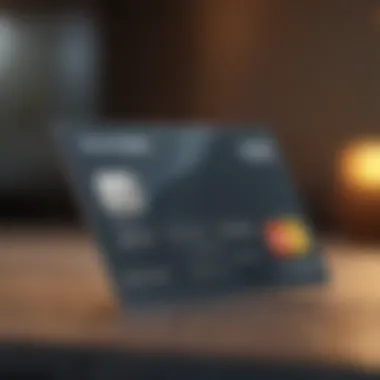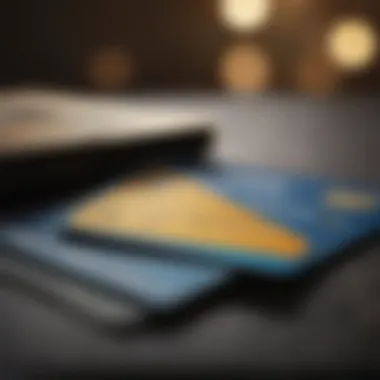Mastering Your Visa Card Balance: A Complete Guide


Intro
Navigating the world of personal finance can feel like steering through a maze, especially when it comes to managing a Visa card balance. Understanding your card balance is not just a matter of keeping track of expenditures; it’s crucial for maintaining financial health and making informed decisions. This article unpacks various elements related to your Visa card, shedding light on effective ways to handle your spending, interpret statements, and optimize payments.
Understanding Financial Literacy
Definition and Importance
Financial literacy encompasses more than just basic math; it’s about making informed and effective decisions with financial resources. In today’s fast-paced economy, having a good grip on your finances isn't just wise—it's necessary. A well-rounded understanding allows individuals, especially young professionals and students, to navigate expenses while avoiding potential pitfalls such as debt traps. Knowing how to interpret your Visa card balance is a foundational skill, essential for anyone looking to manage their spending effectively.
Basics of Financial Literacy
To start, financial literacy includes knowledge of budgeting, saving, investing, and understanding credit. Familiarity with terms like interest rates, credit scores, and financial statements can set you miles ahead in managing your finances. Moreover, one of the essential aspects of financial literacy is recognizing the impact of interest on your Visa card balance. An understanding of how minimum payments are calculated and how interest accrues can make a significant difference in how you manage your card.
Importance of Budgeting
Overview of Budgeting
Budgeting acts as the roadmap to your financial journey. It allows you to allocate your funds wisely and helps you track where your money goes each month. When managing a Visa card balance, a budget helps in setting limits on spending, so you don’t find yourself in the red before the end of the pay period. The beauty of a good budget is that it doesn't restrict your spending; rather, it enables you to prioritize your wants and needs without going into debt.
Benefits of Having a Budget
Keeping a budget has several notable advantages:
- Clarity on Spending: A ensures you know where every penny is going.
- Avoiding Debt: Helps prevent overspending and accumulating credit card debt.
- Financial Goals: Assists in setting and achieving short and long-term financial goals.
- Peace of Mind: Reduces anxiety about money management, allowing you to focus on other essential aspects of life.
"A budget is telling your money where to go instead of wondering where it went."
Overall, understanding your Visa card balance within the context of financial literacy and budgeting makes it possible to take charge of your finances. Mastering these elements will provide a pathway to a more structured approach to both spending and saving, ultimately laying a solid foundation for your future.
Prolusion to Visa Cards
When navigating the financial landscape, Visa cards serve as vital tools for many young professionals, students, and small business owners. Understanding what these cards truly offer lays the groundwork for effective financial management. Visa cards are not just a means to make purchases; they enhance one's ability to manage funds, build credit, and take advantage of perks that come in handy in daily life.
In this section, we will explore what Visa cards are, the different types available, and the critical role they play in consumer finance. This will help demystify the Visa card experience, making it easier for users to navigate their financial journeys with confidence.
What is a Visa Card?
A Visa card is a form of credit or debit card that allows users to conduct transactions conveniently across millions of merchants worldwide. Unlike cash or checks, Visa cards provide a secure method for conducting purchases both in physical stores and online. These cards can either draw from a checking account or be linked to a revolving line of credit, depending on whether they're debit or credit cards.
One key feature that stands out is the global acceptance of Visa cards, making them invaluable for those traveling abroad or engaging in international online shopping. Furthermore, Visa cards come with built-in protections against fraud, adding another layer of security for the cardholder. In essence, a Visa card represents a versatile financial tool that can simplify spending and help users manage their money more effectively.
Types of Visa Cards Available
Visa cards come in various forms, tailored to meet different needs and preferences. Here are some common types you might encounter:
- Visa Credit Cards: Allow users to borrow money up to a certain limit and pay it back over time.
- Visa Debit Cards: Linked directly to a bank account, these cards let users spend what they have without the risk of accumulating debt.
- Visa Prepaid Cards: These can be loaded with a specific amount of money beforehand, making them a good option for budgeting or gifts.
- Business Visa Card: Specifically designed for entrepreneurs and small business owners, these cards often come with features tailored to business expenses, such as higher credit limits and rewards for business-related purchases.
Each type offers distinct advantages and potential drawbacks. Knowing the specifics can empower users to select the card that aligns with their financial habits and goals.
The Role of Visa in Consumer Finance
Visa plays a significant role in modern consumer finance by acting as an intermediary between cardholders, merchants, and banks. This relationship facilitates seamless transactions, ensuring that users can access their funds and credit whenever they need it. Additionally, Visa works to promote financial literacy, providing resources that help individuals make informed decisions regarding their spending and saving habits.
Moreover, Visa often collaborates with financial institutions to offer various benefits, such as cash back, travel rewards, and purchase protections. This not only enhances the cardholder experience but also encourages responsible financial behaviors.
In today’s fast-paced economy, leveraging Visa’s advantages can lead to improved financial stability and opportunities for growth. Understanding the dynamics of this system is crucial for anyone looking to effectively manage their Visa card and overall financial health.
Understanding Card Balances
When it comes to managing your finances, grasping the concept of card balances is paramount. Understanding what comprises your Visa card balance is like having the keys to a well-organized filing cabinet; once you know where everything is, you can find what you need without any hassle. Not only does it help in budgeting and tracking expenses, it also has lasting effects on your financial health and creditworthiness.
A clear understanding of your balance provides insight on expenditures and future spending. It aids in knowing how much you can afford at a glance, preventing unwelcome surprises at the end of the billing cycle. In short, mastering your balance allows you to make educated choices about your spending habits and stay on the straight and narrow path toward financial success.
Defining Card Balance
Simply put, a card balance is what you owe on your Visa card at any given time. It encompasses all spending, yet this amount fluctuates as transactions occur and payments are made. It acts as a snapshot of your financial usage on that specific card, which is vital for monitoring and maintaining your finances effectively.
Being aware of your card balance is more than just knowing how much money you owe. It also helps in strategizing payments and adapting your spending habits in real time.
Components of a Visa Card Balance
Understanding the various components of your Visa card balance is crucial for optimal management. Three major components define this figure: outstanding purchases, pending charges, and credit limit.
Outstanding Purchases
Outstanding purchases represent the amount that you have charged to your credit card but haven’t paid off yet. This is perhaps the most straightforward element of your balance. Once you make a purchase, it is added to your outstanding balance, impacting your financial standing.
The key characteristic here is that this amount earns interest until it’s paid in full. This is what makes carrying a balance risky—interest can pile up pretty fast if you don’t pay off your purchases timely. Knowing your outstanding balance gives you a pulse on your expenses and helps manage your monthly budget better.
Pending Charges
Unlike outstanding purchases, pending charges reflect transactions that have been initiated but not yet finalized. These charges can stem from everyday expenses, such as that morning coffee or dinner out with friends. While it can seem minor, not paying attention to pending charges can lead to confusion about your actual balance.
What sets pending charges apart is their temporary nature; they can fluctuate until the transaction is officially processed. This characteristic offers a window of opportunity to manage spending before it solidifies into your account. On the flip side, if you're not tracking these, they could lead to overdrawing your balance or unknowingly overspending.
Credit Limit
Your credit limit is the maximum amount you are allowed to borrow on your Visa card. This limit is an indicator of your creditworthiness and depends on various factors like income, credit history, and payment behaviors. Understanding this limit is essential for responsible credit card use.
The significance of your credit limit cannot be overstated. It works as a safety net against overspending and serves as a guide in managing your financial life. If you approach or exceed this limit, it can negatively affect your credit score and, ultimately, your ability to secure loans in the future. Keeping within this limit not only avoids fees but also contributes to a healthier credit profile.
Tracking Your Visa Card Balance
Keeping a close eye on your Visa card balance is not just a smart move; it’s a crucial part of managing your personal finances. If you want to maintain control over your spending and avoid potential pitfalls, tracking your balance should be at the forefront of your financial routine. The act of regularly monitoring not only helps you stay within your spending limits but also allows you to spot anomalies or unauthorized transactions that could lead to financial loss. Here’s why paying attention to your balance matters and how you can make the process straightforward and effective.
Importance of Regular Monitoring
Regular monitoring of your Visa card balance can feel like an arduous chore, but it’s absolutely necessary. When you diligently track your spending, you develop a clearer picture of your financial health. You can pinpoint where your money is flowing, ensuring you don’t end up in murky waters when it comes to paying your bills or planning for future expenses.
Not just that, monitoring your balance regularly can help fortify your credit score. Payments that are made late or missed impact your score negatively, so keeping tabs allows you to make timely payments, enhancing your creditworthiness. As the saying goes, "an ounce of prevention is worth a pound of cure"; catching an issue early can save you from a headache later on.
Methods to Check Your Balance
There are several ways to keep tabs on your Visa card balance, and each has its own benefits. Let’s explore the most popular methods available:
Mobile Applications
Mobile banking apps, like those offered by Chase or Bank of America, have revolutionized how you view your Visa card balance. The key characteristic of these apps is their accessibility; you can check your balance anytime, anywhere, right from the palm of your hand. This offers unmatched convenience for today’s busy lifestyle.
One unique feature of many banking apps is real-time notifications. These alerts notify you of transactions and remind you to stay within your limits. While some users might find this feature a bit overwhelming, it's generally recognized as a beneficial tool for keeping an eye on spending habits.
Online Banking Portals
Accessing your Visa card balance through online banking portals is another solid option. These platforms provide a broader view of your financial standing, including transaction history and spending patterns. The key advantage here is the detailed analytics that many portals offer. These analytical tools can help you create budgets and spot trends in your spending.
However, it does require you to sit down in front of a computer, which some might find cumbersome. The trade-off for the deeper insights may justify the occasional hassle, especially for those who are serious about tracking their financial trajectory.
Monthly Statements
Monthly statements are perhaps one of the most traditional methods available for verifying your Visa card balance. Each month, you'll receive a detailed breakdown of your spending, which includes charges, payments, and any fees incurred. The key characteristic of monthly statements is their comprehensive nature; they detail every transaction from the past month, allowing you to spot any discrepancies.
While assessing monthly statements might seem cumbersome in the age of technology, they have an undeniable advantage: you can review them offline and take more time to digest the information. The downside? By the time you receive the statement, it might already be too late to alter spending habits from the previous month.
Remember, understanding your balance is a critical step in securing your financial future. By using a combination of these methods, you can stay empowered and informed regarding your Visa card utilization.
Interpreting Visa Card Statements
Understanding your Visa card statement is crucial for anyone looking to maintain a solid grip on their finances. Not only does it provide a clear view of how much you’re spending, but it also highlights areas where you might want to adjust your habits. If you ignore it or fail to comprehend its contents, you could easily slip into unnecessary debt or rack up fees without even realizing it.


A well-crafted statement tells a story. It reflects your spending patterns, payment habits, and, more importantly, the fees associated with the usage of your Visa card. Recognizing how to read and interpret this document can help you make better financial decisions and ultimately protect your credit score. By comprehending each component, you empower yourself to manage your money efficiently.
Reading the Statement
When you first lay eyes on your Visa card statement, it may appear to be a jumble of numbers and jargon. However, breaking it down into manageable parts can make deciphering it a straightforward task. The statement typically includes:
- Account Summary: This section reveals your balance, available credit, and payment due date.
- Transaction Details: Here, you’ll find a comprehensive list of your purchases, which often includes the transaction date, merchant name, and amount spent.
- Payment Information: Details regarding your minimum payment, due date, and previous balance can be found here.
By focusing on these key areas, you can quickly gauge your financial status. Take time each month to ensure that the transactions recorded align with your receipts. Mismatches can hint at unauthorized activity or simple clerical mistakes.
Identifying Fees and Charges
Keeping track of fees and charges on your Visa card is not just about understanding what you owe; it's about understanding your spending behavior and making informed choices. Here are some specific fees you might encounter:
Annual Fees
Annual fees are often a hallmark of more premium credit cards. The key characteristic of these fees is that they tend to be charged once a year, upfront. While some may view them as a burden, they can also be beneficial if they come with added perks—such as cash back, travel rewards, or access to exclusive events.
Unique features of annual fees typically include:
- Premium rewards programs that may offset the cost.
- No foreign transaction fees, which can save substantial money while traveling.
However, an advantage here is also a disadvantage—if you don’t plan to use the perks, paying a fee can feel like throwing your money down the drain.
Late Fees
Late fees are another common expense that cardholders may face. These charges apply when payments aren’t received by the due date. The key characteristic of late fees is their propensity to compound; they can not only inflate your balance but may also lead to increased interest rates.
The unique feature of late fees is that they often vary by issuer but can climb to steep amounts, sometimes hitting upwards of $39. While paying your card late is usually avoidable with a little forethought, it can also serve as a wake-up call in terms of fostering better financial discipline.
Foreign Transaction Fees
Foreign transaction fees can be surprising to many cardholders. These fees are usually a percentage of each purchase made in a foreign currency, often ranging from 1% to 3%. The key characteristic here is that they can pile up quickly if you travel frequently or shop internationally.
Identifying these charges can lead to cost-saving behaviors. If there are specific cards known for waiving foreign transaction fees, it would be wise to consider them if global spending is part of your lifestyle. The advantage of knowing about these fees means you can plan ahead: choose not to use your Visa in certain circumstances or switch to an alternative that serves your travel needs better.
Understanding these fees can be the difference between financial freedom and anxiety.
Financial Implications of Your Balance
Understanding the financial implications of your Visa card balance is crucial for anyone looking to maintain a healthy financial life. It goes beyond merely knowing what you owe; it encompasses how your spending and payment habits can influence various aspects of your financial well-being. This section looks into how your card balance interacts with your credit score and overall financial health, revealing insights that could steer you away from potential pitfalls.
Impact on Credit Score
Your credit score is like a financial snapshot, and your Visa card balance plays a significant role in shaping that picture. When lenders assess your creditworthiness, they're particularly interested in your credit utilization ratio. This ratio is calculated by dividing your total credit card balances by your total available credit. A higher ratio often signals financial stress, which can ding your score.
For instance, if you have a credit limit of $10,000 and you carry a balance of $3,000, your utilization rate stands at 30%. This is generally acceptable. However, pushing that balance above $7,500 brings your score into the danger zone.
It’s essential to keep that in mind as you ponder:
- What is my current balance?
- Am I close to my limit?
- Have I been making just minimum payments?
Regularly evaluating your balance can help you manage your utilization ratio efficiently, thus protecting your credit score.
Debt and Financial Health
Maintaining a healthy balance on your Visa card not only keeps your credit score in check but also reflects your overall financial health. Carrying a high balance can lead to debt accumulation, which can morph into a heavy burden. If you find yourself only making minimum payments month after month, the interest can stack up quickly. Over time, this habit can spiral into a cycle of debt that feels insurmountable.
Here are some considerations on how your balance relates to debt:
- Interest Rates: The longer you carry a balance, the more interest you’ll pay. If your interest rate is high, you could end up paying significantly more than what you originally charged.
- Debt-to-Income Ratio: This is another critical metric that lenders consider. High card balances can inflate your debt-to-income ratio, making it harder to qualify for loans or mortgages.
- Mental Strain: Beyond numbers, carrying a significant balance can cause anxiety and stress, affecting not only your wallet but also your mental well-being.
"Balancing your credit matters is like walking a tightrope; a little awareness goes a long way in ensuring you don’t tip over the edge."
Learning to manage your balance effectively will empower you to navigate the financial landscape with confidence, allowing you to make informed decisions today for a more secure tomorrow.


Payment Strategies for Your Visa Card
Managing your Visa card balance effectively means understanding greater strategies that revolve around payments. Payment strategies not only help to maintain control over your finances but can also influence your credit score and overall financial health. A well-planned payment approach can improve your capacity to keep debts at bay, manage expenses, and avoid penalties. Here, we dive deeper into payment tactics, exploring the nuances of full payments versus minimum payments as well as the convenience of automated payments.
Full Payment vs. Minimum Payment
When it comes to paying off your Visa card, you essentially have two distinct pathways: full payment or minimum payment. Each option carries its own implications that can significantly impact your wallet and financial standing.
- Full Payment: This is when you settle your entire balance by the due date. Paying the full balance is the gold standard; it not only means that you won't incur interest charges but also reflects positively on your credit report. It shows lenders that you're financially responsible, which can pave the way for better credit opportunities in the future. Moreover, clearing your balance can provide peace of mind and reduce the stress of managing debt.
- Minimum Payment: This is often a lower amount set by your card issuer. While it can be tempting to only pay the minimum, it can lead you down a slippery slope. Most likely, you’ll incur interest on the remaining balance, meaning that you will end up paying much more over time. For young professionals and students, budgeting for just the minimum may seem feasible in the short-term; however, it may lead to long-term financial stress.
In essence, aiming for full payment is the advisable route, but it’s essential to assess your personal financial circumstances. It’s about finding that delicate balance—understanding when it's okay to pay just the minimum without compromising your financial health.
Setting Up Automatic Payments
Automatic payments can be a game changer for managing your Visa card. Setting this up means you won’t have to individually remember every due date; it simplifies your payment process and helps you avoid late fees.
- Convenience: Setting up automatic payments allows you to sidestep the monthly hassle of remembering payment dates. Just select a consistent amount or your full balance to be deducted every month.
- Avoiding Late Fees: Once you enroll in automatic payments, it dramatically reduces the risk of forgetting to pay on time. Missing payments can incur hefty charges and negatively affect your credit score.
- Flexibility & Control: Many card issuers allow you to adjust settings for automatic payments. You can start small and increase payments as your financial situation improves. This brings a layer of security knowing your payment habits can evolve as your life circumstances change.
However, it's important to ensure sufficient funds in your account to avoid overdrafts when automatic payments are processed. Regular updates or monitoring are crucial to keep the process seamless.
"Setting smart strategies for payments can change the course of your financial future."
In wrapping up this point, addressing payment strategies may seem less glamorous but are undeniably essential. Understanding the implications of your choices can empower young professionals and students alike to make informed decisions about their finances, setting the stage for greater financial freedom.
Tips for Managing Your Visa Card Balance
Navigating the financial landscape with a Visa card comes with its own set of challenges and rewards. Understanding how to expertly manage your card balance is an essential skill that can help you avoid pitfalls like accruing unnecessary debt, paying hefty interest fees, and experiencing a drop in your credit score. Effective management equates to unlocking the full potential of your card while maintaining your financial health. This section delves deeper into useful strategies that young professionals, students, and small business owners can adopt to keep their Visa card balances in check.
Creating a Payment Plan
One of the most advantageous steps you can take is to establish a payment plan. This is not just about tossing cash at your outstanding balance; it’s about doing so strategically. A payment plan provides clarity and direction, allowing you to prioritize your payments based on factors like interest rates and due dates. Here’s how to get started:
- Assess Your Balance: Look at what you owe and assess your financial situation. Knowing exactly how much you have due will prevent you from getting caught off-guard.
- Set a Monthly Goal: Decide on a realistic amount you can dedicate to your credit card each month. Whether it’s the full balance or a fraction, consistency is key.
- Customized Approach: Tailor your plan to fit other financial obligations. For many, that means balancing student loans, rent, and daily expenses.
It’s beneficial to track your progress with a spreadsheet or a budgeting app. Keeping an eye on your payments can motivate you and shed light on your spending habits. A methodical approach can not only lessen your balance but might also elevate your credit score over time.
Budgeting for Your Card Usage
Budgeting is akin to mapping out a journey; you wouldn’t set out on a road trip without a GPS, right? Developing a budget that encompasses your Visa card usage isn’t just smart; it’s necessary for financial wellbeing. Here are some guidelines to help you craft an effective budget:
- Categorize Your Spending: Break down your expenses into categories—housing, food, entertainment, and Visa payments. This gives you perspective on where your money travels each month.
- Allocate Wisely: Based on your categorized spending, allocate specific amounts to each section, including a portion for your Visa card. Having a clear idea will keep your usage within healthy limits.
- Review and Adjust: At the end of each month, take a look back. Are you sticking to your budget, or is there room for adjustment? Flexibility in budgeting can lead to better control over your finances.
- Use Financial Tools: Leverage tools such as budgeting apps or even a simple Excel spreadsheet to monitor your progress. This transparency allows you to see if you’re staying within your financial target.
By adopting a budgeting mindset and aligning your card use with your overall financial plan, you position yourself for success. You can live within your means while still enjoying the benefits of a Visa card, without falling into the credit trap.
"A well-planned budget is the first step in controlling your financial destiny."
Employing these tips for managing your Visa card balance will strengthen your financial foundation, and put you on the path to becoming savvy with your expenditures.
Closure
When navigating the maze of personal finance, managing your Visa card balance emerges as a cornerstone of financial acumen. This section ties together the previous discussions and emphasizes the relevance of understanding your card balance in fostering financial health. It's not just about knowing how much you owe at the end of the month; it's about grasping the full scope of your financial landscape. By recognizing the nuances of card usage, tracking your balances, and making informed payment choices, you can significantly minimize stress and enhance your overall financial well-being.
In our earlier sections, we delved into different components of a Visa card balance, which include outstanding purchases, pending charges, and your credit limit. Understanding these elements allows you to monitor spending and anticipate future payments more effectively. Additionally, keeping an eye on fees associated with your card can save you unexpected financial strain. The importance of establishing payment strategies and budgeting also cannot be overstated; they forge the path to sustained fiscal responsibility.
Moreover, this guide underscores the significance of cultivating financial literacy. As you reevaluate your balance regularly and become adept at interpreting statements, you're not just managing a card; you are building a resilient foundation for your financial future. Remember, the implications of how you use your Visa card extend far beyond the monthly billing cycle; they have a lasting effect on your credit score as well.
"Financial education is not a luxury; it is a necessity for navigating today's complex economic landscape."
Recap of Key Points
A brief revisit of key points discussed in this article highlights how intertwined Visa cards are with one's financial habits. Key takeaways include:
- Understanding Card Balance: Recognizing what comprises the balance helps in effective tracking of spending and planning payments.
- Monitoring Your Balance: Regular checking through mobile apps, online banking, or monthly statements ensures you stay informed.
- Payment Strategies: Choosing between full payments and minimum payments can greatly impact your debt levels and financial health.
- Budgeting Tips: Crafting a solid budget around your card usage facilitates better financial management.
These elements, when applied diligently, contribute to a well-rounded financial strategy that empowers users.
Encouragement for Financial Literacy
As we edge towards a world increasingly driven by consumer credit, bolstering financial literacy is indispensable. Young professionals, students, and small business owners can particularly benefit from acquiring a nuanced understanding of how credit works. With tools like Visa cards at your disposal, knowledge becomes empowerment.
Engage in continuous education about finances—whether through reputable websites, workshops, or even discussions in community settings like forums or Reddit. Staying informed not only aids in day-to-day decisions but also prepares you for larger financial commitments ahead, like mortgages or business loans.



